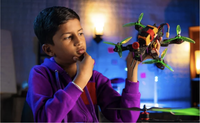Dr. James Kaishian, Superintendent of Schools at Briarcliff Manor Schools, recently shared his experiences and insights at the Learning Counsel Leadership Symposium at PNW BOCES. In his presentation, Dr. Kaishian emphasized the critical role of integrating technology into education while maintaining a delicate balance with the human experience. He dispelled the notion of an "either-or" scenario, arguing that technology, when used wisely, can enhance rather than diminish our lives. This article explores Dr. Kaishian's three beliefs, three essential questions, and three guiding principles for ensuring that technology integration does not come at the expense of our humanity.
- Technology as a Tool for Connection: Dr. Kaishian believes that technology can foster connection among students by breaking down physical barriers and facilitating collaboration. Through virtual exchanges and online projects, students can engage with peers from diverse backgrounds, learning to appreciate the beauty of a global community. The emphasis is on using technology to teach students how to interact successfully in a global context, promoting understanding and prosperity.
- Media and Information Literacy: The superintendent stresses the importance of teaching students to use technology as a tool for research, analysis, and problem-solving. By instilling media and information literacy, students learn to critically evaluate online content, discerning the author's intent and separating facts from fiction. This approach aims to address the current lack of critical thinking and media literacy contributing to societal divisions.
- Navigating the Digital Landscape with Discernment: Dr. Kaishian's third belief centers on guiding students in navigating the digital landscape with discernment. This involves encouraging intellectual curiosity, prompting students to ask questions such as "Who is the author?" and "What is their intent?" By instilling these habits, educators can help students develop a sense of responsibility and awareness when engaging with technology.
Essential Questions:
- How Can Technology Enhance the Real-world Classroom Experience? Dr. Kaishian challenges educators to consider how technology can be harnessed to create classrooms that reflect the real world. By embracing technological advancements, educators can prepare students for the complexities of the modern world and bridge the gap between the virtual and the real.
- What is the Balance Between Technology and Human Connection? The delicate balance between technology and human connection is a key point of discussion. In an age of rapid technological advancement, educators must navigate this terrain with wisdom and empathy, ensuring that the growth of young minds is nurtured while maintaining a strong connection to humanity.
- How Can Educators Avoid Losing Humanity in the Pursuit of Tech Integration? Dr. Kaishian encourages educators to share their experiences, inspire others, and learn from mistakes. By addressing this essential question, educators can collaboratively work towards a balanced approach to technology integration that prioritizes both educational advancement and the preservation of our humanity.
Guiding Principles:
- Purposeful and Wise Use of Technology: Educators must use technology purposefully and wisely, likening it to a light switch that can either illuminate or cast shadows on the human experience. By exercising control over technology use, educators can ensure that it enhances, rather than diminishes, the lives of students.
- Fostering Critical Thinking and Media Literacy: Teaching students to engage in self-editing processes, such as blogging with thoughtful critiques, contributes to the development of critical thinking skills. Additionally, educators must guide students in media and information literacy, promoting discernment and intellectual curiosity to navigate the digital landscape successfully.
- Maintaining the Balance Between Digital and Human Connection: Dr. Kaishian stresses the responsibility of educators to strike a balance between the digital and human realms. By nurturing this balance, educators contribute to the growth of young minds while preparing them for the demands of an ever-evolving technological landscape.
Dr. James Kaishian's presentation at the Learning Counsel Leadership Symposium provides valuable insights into the integration of technology in education without sacrificing our humanity. By fostering connections, promoting media literacy, and maintaining a careful balance, educators can ensure that technology becomes a tool for enlightenment rather than a source of distraction. The guiding principles and essential questions outlined by Dr. Kaishian serve as a roadmap for educators navigating the dynamic intersection of technology and humanity in the modern classroom.
See the full presentation below.











